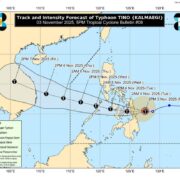More PH airports a must in postpandemic era
The Philippines sees the need to stay on course on building more international gateways and improving capacity for existing ones as there’s no stopping airline passengers from hopping on those flights after years of strict COVID-19 lockdowns. The aviation sector has been seeing some recovery for both domestic and international flights, with Ninoy Aquino International Airport (Naia) projecting 45 million passenger movements by year-end or about 94 percent of prepandemic volume. Next year, passenger traffic is expected to breach 50 million, says Bryan Co, former officer in charge of Manila International Airport Authority (MIAA). By 2030, the country’s main gateway is estimated to accommodate 90 million passengers—nearly double the 2024 estimate. With passenger volume only expected to grow, Co says a multi-airport approach is a necessity if the country wants to provide quality service for the passengers, noting that Naia cannot do this alone. This airport, after all, is already congested. It has a 32-million passenger capacity, which is below the actual volume it caters to.
“We’re banking on the Naia rehabilitation project, as well as the Bulacan and Clark to carry us through 2030,” Co tells the Inquirer in an interview.
The government is now on the lookout for a private sector partner who will take on the P170.6-billion Naia rehabilitation project. It includes upgrades of passenger terminals and airside facilities such as runways, aircraft parking areas and airfield lighting; and provision of facilities enabling intermodal transfers at the terminal.
The key improvement is increasing the number of flights being accommodated by the airport at certain periods to service more passengers, Co explains. Under the contract, the private proponent must achieve 48 aircraft movements per hour from the current 41 jets.
Meanwhile, the P740-billion New Manila International Airport (Nmia) project in Bulacan is currently under development. The airport project is designed to have four parallel runways, a terminal and an interlinked infrastructure network that includes expressways and railways. It is seen to generate over a million jobs.
The Nmia project, led by San Miguel Corp., is targeted to be completed by 2027.
Lastly, Clark International Airport, operated by the Luzon International Premeire Airport Development Corp. (Lipad), opened in May 2022 a four-level building that can accommodate 8 million passengers annually.
Lipad is a special purpose company comprising Filinvest Development Corporation, JG Summit Holdings Inc., Philippine Airport Ground Support Solutions Inc. and Changi Airports Philippines (I) Pte. Ltd. The consortium was awarded the operations and management contract in August 2019.
No delaysInfrawatch PH convener Terry Ridon agrees the country must ramp up airport upgrades in order to address the passenger influx in the coming years, stressing the need to speed up the Naia rehab project.
“A multi-airport strategy for the Greater Capital Region is the best way forward to managing the expansion of passenger volume in the medium and long term,” he tells the Inquirer.
“We hope that there are no further delays in the scheduled bidding of the Naia rehabilitation project, as the government cannot expect an expansion of foreign investment if it cannot make immediate and necessary improvements to its main international gateway,” he adds.
The solicited bidding process began in August. By the first quarter of 2024, the Department of Transportation (DOTr) hopes to award the contract to the concessionaire with the best proposal.On Dec. 27, the DOTr received proposals from four bidders, including the Manila International Airport Consortium, Asian Airport Consortium, GMR Airports Consortium and SMC SAP & Co. Consortium.
A completeness check of the documentary requirements was conducted following the submission. After this, the DOTr will further scrutinize the technical and financial qualifications of the bidders.
“This is a very important project of the government as we want all our passengers to improve their travel experience. We’re happy that you all participated with this very important project,” Transportation Secretary Jaime Bautista said during the opening of bids.
Project pipelineThe DOTr has also set its goal of completing P1 trillion worth of airport projects across the country, including Tuguegarao Airport, San Vicente Airport, Tacloban Airport, Antique Airport, Bacolod-Silay Airport, Catbalogan Airport, Davao International Airport, M’lang Airport, Sanga-Sanga Airport and Ozamiz Airport.
Bautista earlier raised the need to improve air transport following the resurgence of passenger movements at the airports.Earlier this year, the National Economic and Development Authority approved the P12.75-billion Laguindingan International Airport project. The contract includes the upgrade, expansion, operations and maintenance of the Misamis Oriental airport.
The $11-billion Sangley Point International Airport by the Virata-Yuchengco-led consortium, meanwhile, is awaiting its groundbreaking ceremony. The Cavite airport is designed to have an annual capacity of 25 million passengers initially, with the goal of eventually increasing this to 75 million passengers. INQ















